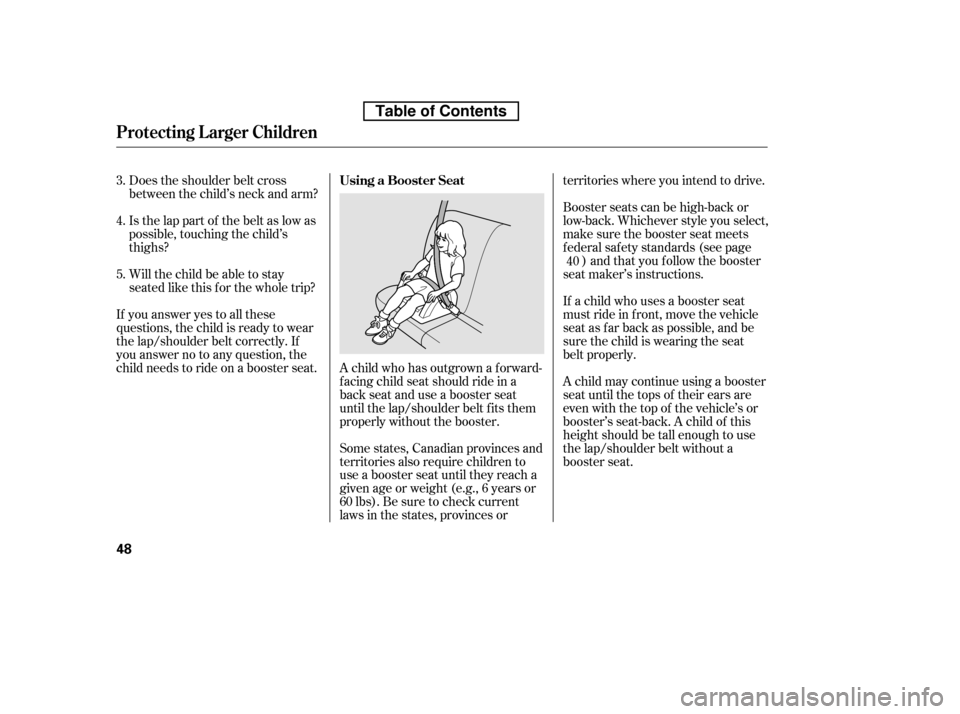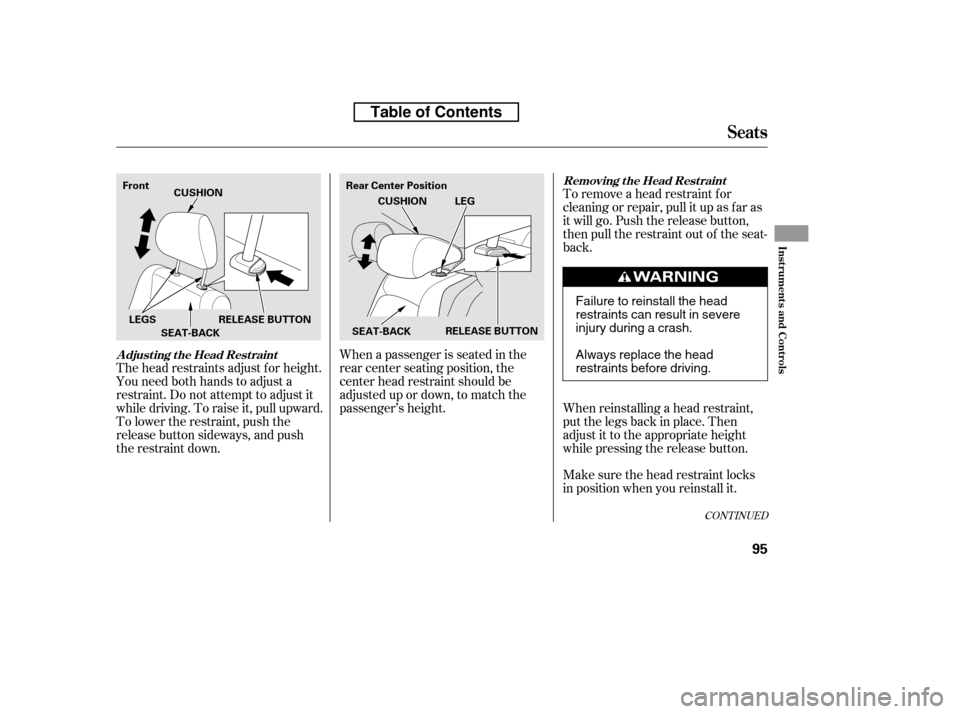Page 56 of 387
To install a LATCH-compatible child
seat:Move the seat belt buckle or
tongue away f rom the lower
anchors.
Make sure there are no objects
near the anchors that could
prevent a secure connection
between the child seat and the
anchors. Place the child seat on the vehicle
seat, then attach the seat to the
lower anchors according to the
child seat maker’s instructions.
Some LATCH-compatible seats
have a rigid-type connector as
shown above.
Your vehicle is equipped with
LATCH (Lower Anchors and
Tethers for CHildren) at the outer
rear seats.
The location of each lower anchor is
indicated by a small button above the
anchor point.
The lower anchors are located
between the seat-back and seat
bottom, and are to be used only with
a child seat designed f or use with
LATCH.
1. 2.3.
Installing a Child Seat
Installing a Child Seat with
LATCH
42
LOWER ANCHORS
Rigid type
BUTTON
Table of Contents
Page 57 of 387
Whatever type you have, f ollow
the child seat maker’s instructions
f or adjusting or tightening the f it.Lif t the head restraint (see page
), then route the tether strap
through the legs of the head
restraint and over the seat-back,
making sure the strap is not
twisted. Attach the tether strap hook to the
tether anchor, then tighten the
strap as instructed by the child
seat maker.
Other LATCH-compatible seats
have a f lexible-type connector as
shown above. If the tether strap is too long and
cannot be tightened f irmly, f ind a
route where the strap can be
tightened securely.
Push and pull the child seat
f orward and f rom side-to-side to
verif y that it is secure.
6.
5.
4. 7.
95
Installing a Child Seat
Driver and Passenger Saf ety
43
TETHER STRAP
HOOK
Flexible type ANCHOR
Table of Contents
Page 58 of 387
When not using the LATCH system,
all child seats must be secured to the
vehicle with the lap part of a lap/
shoulder belt.With the child seat in the desired
seating position, route the belt
through the child seat according
to the seat maker’s instructions,
then insert the latch plate into the
buckle and remove any slack f rom
the lap portion of the belt.To activate the lockable retractor,
slowly pull the shoulder part of the
belt all the way out until it stops,
then let the belt f eed back into the
retractor.
Af ter the belt has retracted, tug on
it. If the belt is locked, you will not
be able to pull it out. If you can pull
thebeltout,itisnotlocked,and
you will need to repeat these steps.
In addition, the lap/shoulder belts in
all seating positions except the
driver’s have a lockable retractor
that must be activated to secure a
child seat.
1.2. 3.
Installing a Child Seat with a L ap/
Shoulder Belt
Installing a Child Seat
44
Table of Contents
Page 62 of 387

A child who has outgrown a forward-
f acing child seat should ride in a
back seat and use a booster seat
until the lap/shoulder belt f its them
properly without the booster.
Does the shoulder belt cross
between the child’s neck and arm?
Is the lap part of the belt as low as
possible, touching the child’s
thighs?
Will the child be able to stay
seated like this f or the whole trip?
If you answer yes to all these
questions, the child is ready to wear
the lap/shoulder belt correctly. If
you answer no to any question, the
child needs to ride on a booster seat. Booster seats can be high-back or
low-back. Whichever style you select,
make sure the booster seat meets
f ederal saf ety standards (see page
) and that you f ollow the booster
seat maker’s instructions.
If a child who uses a booster seat
must ride in f ront, move the vehicle
seat as far back as possible, and be
sure the child is wearing the seat
belt properly.
A child may continue using a booster
seat until the tops of their ears are
even with the top of the vehicle’s or
booster’s seat-back. A child of this
height should be tall enough to use
the lap/shoulder belt without a
booster seat.
Some states, Canadian provinces and
territories also require children to
use a booster seat until they reach a
given age or weight (e.g., 6 years or
60 lbs). Be sure to check current
laws in the states, provinces or territories where you intend to drive.
3. 4. 5. 40
Using a Booster Seat
Protecting L arger Children
48
Table of Contents
Page 69 of 387

This section gives inf ormation about
the controls and displays that
contribute to the daily operation of
your vehicle. All the essential
controls are within easy reach............................Control Locations . 56
............................
Instrument Panel . 57
..........
Instrument Panel Indicators . 59
.............................................
Gauges . 66
..............
Display Change Button . 66
....................
Inf ormation Display . 67
..................................
Fuel Gauge . 70
...................
Temperature Gauge . 70
Controls Near the Steering ...........................................
Wheel . 71
.
Windshield Wipers and Washers . 72
.........
Turn Signals and Headlights . 73
............
Daytime Running Lights . 74
........................................
Fog Lights . 74
........
Instrument Panel Brightness . 75
.................
Hazard Warning Button . 76
.................
Rear Window Def ogger . 76
..........
Steering Wheel Adjustment . 77
...............................
Keys and Locks . 78
........................
Immobilizer System . 79
................................
Ignition Switch . 80
......................................
Door Locks . 81
......................
Power Door Locks . 82
..............
Childproof Door Locks . 82
.
Auto Door Locking/Unlocking . 83
.....................
Auto Door Locking . 83 .................
Auto Door Unlocking . 85
................................................
Trunk . 88
........
Emergency Trunk Opener . 89
.......................
Remote Transmitter . 90
.................................................
Seats . 93
..................................
Seat Heaters . 100
............................
Power Windows . 101
.......................................
Moonroof . 102
...........................................
Mirrors . 103
...............................
Parking Brake . 105
...............................
Interior Lights . 105
.........
Interior Convenience Items . 107
.....................
Beverage Holders . 108
.........
Accessory Power Socket . 108
..................................
Glove Box . 108
.............
Console Compartment . 108
Instruments and Controls
Inst rument s and Cont rols
55
Page 107 of 387
�µ
See pages f or important saf ety
inf ormation and warnings about how toproperly position seats and seat-backs. 11 13
Make all adjustments bef ore you
start driving.
To adjust the seat f orward or
backward, pull up on the bar under
the seat cushion’s f ront edge. Move
the seat to the desired position, and
releasethebar.Trytomovetheseat
to make sure it is locked in position.Once a seat is adjusted correctly,
rock it back and f orth to make sure it
is locked in position.
To change the seat-back angle, pull
up on the lever on the outside of the
seat bottom.
FrontSeatAdjustments
Seats
Inst rument s and Cont rols
93
Table of Contents
Page 108 of 387
See page f or important saf etyinf ormation and a warning aboutimproperly positioning head restraints. 13
The height of your driver’s seat is
adjustable. To raise the seat,
repeatedly pull up the lever on the
outside of the seat cushion. To lower
the seat, push the lever down
repeatedly. Your vehicle is equipped with head
restraints in all seating positions to
help protect you and your
passengers f rom the likelihood of
whiplash and other injuries.
They are most ef f ective when you
adjust them so the center of the back
of the occupant’s head rests against
the center of the restraint.
Driver’s Seat Height Adjustment Head Restraints
Seats
94
Table of Contents
Page 109 of 387

CONT INUED
To remove a head restraint f or
cleaning or repair, pull it up as f ar as
it will go. Push the release button,
then pull the restraint out of the seat-
back.
When reinstalling a head restraint,
put the legs back in place. Then
adjust it to the appropriate height
while pressing the release button.
Make sure the head restraint locks
in position when you reinstall it.
When a passenger is seated in the
rear center seating position, the
center head restraint should be
adjusted up or down, to match the
passenger’s height.
The head restraints adjust f or height.
You need both hands to adjust a
restraint. Do not attempt to adjust it
while driving. To raise it, pull upward.
To lower the restraint, push the
release button sideways, and push
the restraint down.
Seats
Removing t he Head Rest raint
A djust ing t he Head Rest raint
Inst rument s and Cont rols
95
Rear Center Position
Front
RELEASE BUTTON
SEAT-BACK CUSHION
LEGS RELEASE BUTTON SEAT-BACKCUSHION
LEG
Failure to reinstall the head
restraints can result in severe
injury during a crash.
Always replace the head
restraints before driving.
Table of Contents